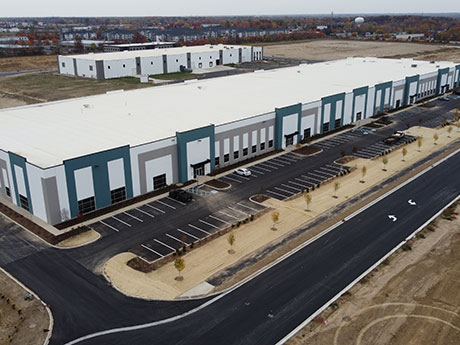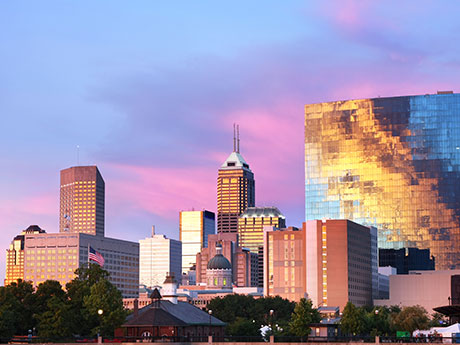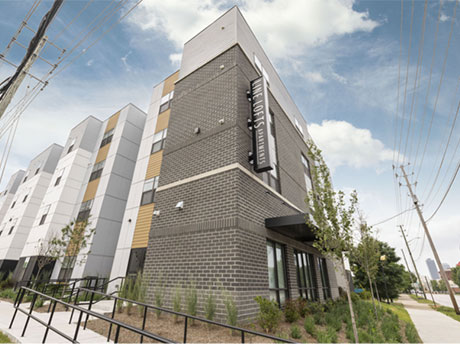By Ken Martin, JLL The Indianapolis industrial real estate market ended 2022 nearing a record high for a single year with more than 19.6 million square feet of absorption. Much of this was recorded in Hendricks, Johnson and Hancock counties with total year-end net absorption of 7.3, 6.4 and 3.2 million square feet, respectively. These submarkets continue to offer tenants excellent access to both interstate highways to transport goods across the country, as well as strong employment bases. Developers and tenants often cite employment bases as their No. 1 criteria in selecting an optimum site. With vacancy at an all-time low of sub 5 percent for the majority of 2022, developers and owners were able to push rents as demand outstripped supply. As recently as two to three years ago, rents were consistently in the high $3’s per square foot range and now we consistently see rents in the $5 per square foot range or higher. Year-end asking rents averaged $5.54 per square foot overall and $6.48 per square foot for mid-sized warehouse space. In some markets, however, rents for warehouse space were well above the average. In the central business district, for example, asking rates for warehouse …
Indiana
By Steve LaMotte Jr., CBRE With 2021, a record year for asset appreciation and fundamentals, 2022 marked a turning point in the apartment space across the nation. Multifamily leasing velocity, rent growth and occupancy levels have seemingly reached their current peak levels and begun to cool. Instability in the capital markets throughout much of 2022 encouraged many on both the buy and sell sides to wait it out, looking for signs of stability. However, despite the turbulence and the pause, the multifamily sector has remained resilient and is expected to maintain its claim as the preferred asset classification in 2023. Further, metro Indianapolis has been a standout performer in every meaningful measurement. Now widely regarded as an emerging star of the Midwest, metro Indianapolis has earned its place as the nation’s rent growth leader in the back-to-back months of October and November of 2022, according to Yardi Matrix. The metro has outperformed many major markets while maintaining its characteristic affordability. According to research from CBRE Econometric Advisors, the average metro rent of $1,200 per unit ($1.30 per square foot) shows that metro Indianapolis will deliver outsized rent growth in times of distress while remaining one of the most affordable metro’s …
By Traci Kapsalis, JLL It’s no secret that the COVID-19 pandemic turned every office market across the globe upside down. In the process, quality of life, health and well-being have become top priorities for office workers, as well as a push for hybrid and flexible working models. To understand and support these evolving expectations, local governments, employers and landlords are working together to identify and shape their new future of work. In fact, new research from JLL reports that the next three years will be a critical phase for commercial real estate strategy, representing a crucial window of opportunity that will determine how successful companies (and cities) will be in adapting to rapid changes. At the crossroads of America, the Indianapolis market is well on its way to a reimagined office environment. Here are three demonstrable signs. 1. Flight to quality dominates the office market Leasing activity for Class A office properties is strong in Indianapolis. According to a recent report, activity in this sector is reaching new heights as it achieved 248,000 square feet of occupancy growth in the second quarter — the highest in a single quarter in over four years — and hit record-high rents of almost …
The United States has been experiencing a housing crisis for years, one that is perpetuated by the COVID-19 pandemic. Whether it’s a lack of affordable housing properties for low-income families, a steady increase in housing prices over the years or exponentially high demand for new homes, the U.S. housing market within the past decade has been a wild ride. Indianapolis growth In the heart of Indiana, we’re seeing a hopeful trend. Indianapolis (Indy) was ranked as the fourth best housing market positioned for growth in 2022. A variety of factors could contribute to this distinction. For one, Indy is a thriving city and centrally located — not just within the state, but in the U.S. It’s home to two professional sports teams, and recently named one of the best cities for creating tech jobs by Forbes, with Fortune 500 corporations like Eli Lilly and Salesforce headquartered throughout the vibrant downtown. Marquee universities such as IUPUI, Butler and IU Medical School also bring more jobs into the fold. The 2020 Census found that metropolitan areas like Indianapolis are at the forefront of the state’s growth. Marion County remains the most densely populated county with more than 950,000 residents. Currently, the average …
By Chris Bruzas, Berkadia Like all markets, Indianapolis is hoping for a return to more normal investment activity for commercial real estate in 2021. So far, the signs are positive, especially for the multifamily sector. The end of 2020 saw a pickup in multifamily sales activity nationally, a result of strong appetite from sidelined capital, continued positive collections trends and occupancy trends, and positive signals from the vaccine rollout. Demand forecasts Indianapolis has steadily been gaining favor with investors, given its economic stability, steady population growth and growing renter interest in secondary and tertiary markets. According to Berkadia’s 2021 forecast, Indianapolis continues to set the standard for urban renewal and economic development. Regional job creation, including at Bottleworks District, Indiana University Health and Amazon, continue to attract new residents. More than 13,000 apartment units were delivered in the past five years with demand continuing to rise. At the end of 2020, occupancy in the metro area was at 95.1 percent, reaching a 20-year peak. Underpinning healthy apartment occupancy is housing demand created by a consistent net migration of about 12,000 people annually and rising household formation. Current opportunities Like the rest of the country, Indianapolis continues to feel the impact …
By Chris Bruzas, Berkadia While the COVID-19 pandemic has had a dramatic impact on the commercial real estate industry, bright spots have emerged across the multifamily landscape. Nationally, secondary and tertiary markets demonstrate resilience and strong performance, despite challenging circumstances. One of these bright spots is Indiana. Since the start of the year, Berkadia’s investment sales and mortgage banking teams have closed more than $498 million in combined sales and financing across the state. While Indiana has long been a solid market in the Midwest, in recent years it has emerged as particularly attractive to investors for a few key reasons. Available scale The ability to acquire scale is increasingly important to investors looking to break into new markets and MSAs. Immediate scale is attractive for several reasons. For investors, acquisition at scale enhances geographic and unit diversification at the outset. It also allows investors, specifically those new to the region, to maximize business efficiencies on expenses. If a new buyer can acquire 1,000 units in proximity, they can reduce the burden of staff, construction costs and travel costs, to name a few. Additionally, it helps with leasing. If a prospective tenant tours a property that doesn’t have floor plans …
Indianapolis is a humble midwestern city that often seems to fly under the radar, but for those willing to take a closer look, they will find more than just a famous racetrack and cornfields. Indianapolis is a dynamic city with a thriving commercial real estate market. Sitting as the 14th-largest city in the U.S., Indianapolis is the economic heart of the region and has experienced steady growth over the past decade — and with true Hoosier hospitality. Here’s a look at what’s happening and what’s to come in the Indianapolis market. Downtown Indianapolis has rapidly evolved over the last few years. The “Circle City” gained momentum through the emergence of a thriving technology sector and steady employment gains in an already economically diverse business landscape. Those influences added to the convenience and tourism that make downtown a desirable destination for retailers. Increased interest from brands has spurred new development and better amenities. An additional 1 million square feet of first-floor commercial space has been added in downtown Indianapolis over the last eight years, and an additional 400,000 square feet is expected over the next few years — a firm foundation that tells an incredible story of growth and investment. Mass …
The Indianapolis industrial market somehow heated up even more throughout 2019, setting several all-time records along the way and setting the table for another strong year in 2020. Landlords and tenants showed just how strong the market remained throughout 2019, with absorption across all industrial property types besting its previous record by nearly a third. A total of 11.4 million square feet was absorbed throughout the market in 2019. That blew away what was a record at the time — 8.9 million square feet absorbed in 2018. Tenants were active all throughout the market, with 17.3 million square feet of space leased over the course of the year. That’s up from just under 14 million square feet that had been leased in 2018. While all sectors of the market attracted plenty of attention, the southwest and northwest Indianapolis markets saw the most action, with 5.3 million square feet leased in the southwest, and another 5 million square feet leased in the northwest. The activity applied to both small and large tenants, with new projects all over the metro leasing up quickly. The city’s largest deal was a 933,000-square-foot lease to Energizer at Franklin Tech Park within a year of Sunbeam …
Demographic shifts and the subsequent demand for affordable housing are currently impacting the greater Indianapolis multifamily sector, but the most marked influence is increased and expanded investor interest. Demographic shifts in population are influencing developers and owners in their long-term decision making when it comes to the multifamily sector. Two primary factors are at play. One, the traditional renter’s segment is changing as millennials age and delay having children. Two, national population projections are showing a decline in the prime renter’s segment as Baby Boomers begin to move into seniors housing. As a result, developers and owners are beginning to plan more senior living communities. Millennials are also impacting affordable housing occupancy rates as they want to live in walkable and amenity-rich areas without the cost of high-end apartments. This is leading to more rehabbed properties. At the moment, Class C properties in the Indianapolis area are reflecting greater occupancy movements, as occupancy declines when properties become distressed and increases when they are purchased and rehabbed. Additionally, college debt is delaying graduates in purchasing traditional homes. Both of these factors are causing occupancy rate increases which, in turn, result in a shortage of affordable housing. New housing construction costs are …
Recently, my national research colleagues released “The Top 10 Commercial Real Estate Trends for 2019,” a piece featuring predictions on subjects such as trade tensions, labor shortages and the evolution of “co-everything.” Of all the predictions, one stood out as being especially relevant for the Indianapolis industrial market as we inch further into 2019. Indianapolis has lacked industrial space for occupiers seeking to grow, particularly in smaller segments. The great news is that the market is well on its way to remedying this ailment. Demand causing shortage As we all know, the industrial sector is undergoing an e-commerce revolution. This has created a rush of demand by retailers and third-party logistics (3PL) providers for distribution and warehouse space, especially in cities like Indianapolis, which historically has been recognized for logistics strength. As a result, industrial market fundamentals have generally tightened across much of the United States. In the fourth quarter of 2018, the U.S. industrial vacancy rate fell to 4.8 percent, the lowest rate on record. Similarly, Midwestern markets currently sitting at 4.8 percent vacancy have experienced a 50-basis point decline in vacancy since the fourth quarter of 2017. Pair that with north of 111.5 million square feet of …
Newer Posts











